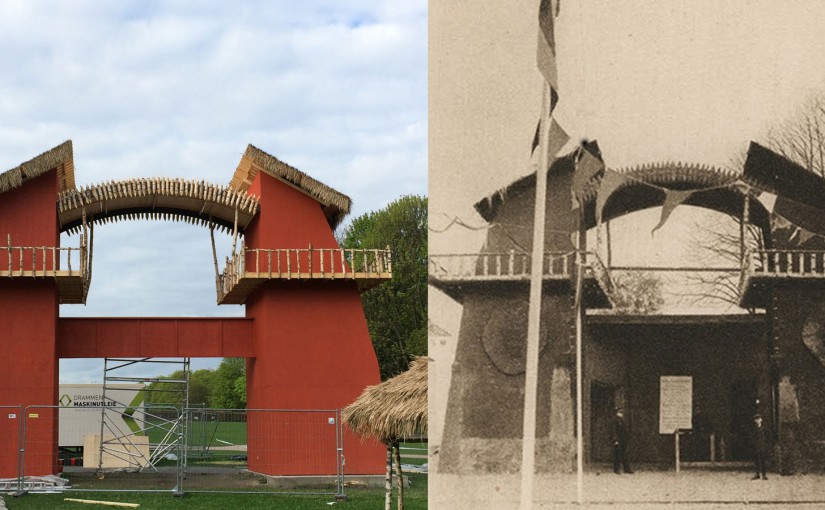European Attraction Limited

The human zoo, Kongolandsbyen, originally created in 1914 by the entertainment company European Attraction Limited, was rebuilt 100 years later by Fadlabi and Lars Cuzner.
Centred around the make up and build up of Scandinavian style superiority, it was a project that was done with a very literal reading of what the public is. During several years created in, and in large part, by the public, whatever direction that would take.
Lars Cuzner and Fadlabi’s project “European Attraction Limited” was an artistic endeavor that culminated in 2014 after a four-year research and development process. The project aimed to recreate and recontextualize “Kongolandsbyen” (The Congo Village) exhibition from Norway’s 1914 centennial celebration, which had displayed African individuals in a human zoo-like setting.
Research Process
The artists’ research began in 2010 when they discovered information about the 1914 exhibition. Surprised by the lack of public awareness surrounding this historical event, Cuzner and Fadlabi embarked on an extensive investigation into Norway’s colonial past and its implications for contemporary society.
Their four-year research process involved:
- Historical analysis of the 1914 exhibition
- Exploration of Norway’s role in colonialism
- Examination of collective memory and national identity
- Engagement with scholars, activists, and community members
- Development of artistic strategies to address sensitive historical material
Project Development
As the project evolved, Cuzner and Fadlabi faced numerous challenges:
- Ethical considerations regarding the recreation of a problematic historical event
- Balancing artistic expression with social responsibility
- Navigating public discourse and potential controversy
- Securing funding and institutional support
The artists aimed to use their project as a catalyst for public dialogue about racism, historical amnesia, and national identity in Norway.
Anti-climactic Opening
Despite the extensive research and preparation, the final unveiling of “European Attraction Limited” in 2014 was described as anti-climactic. This outcome can be attributed to several factors:
- Public controversy: The project generated significant debate and criticism before its opening, potentially overshadowing the actual event.
- Expectations vs. reality: The four-year buildup may have created unrealistic expectations among audiences and critics.
- Artistic interpretation: The artists’ approach to recreating the historical exhibition might have differed from public expectations.
- Contextual shifts: Changes in social and political discourse during the project’s development could have affected its reception.
- Curatorial decisions: The presentation and framing of the project may have influenced its impact on viewers.
The anti-climactic nature of the opening raises questions about the effectiveness of long-term artistic research projects in addressing complex historical and social issues. It also highlights the challenges of translating extensive research into impactful public art.
In conclusion, Cuzner and Fadlabi’s “European Attraction Limited” represents a significant attempt to confront Norway’s colonial history through art. While the project’s final presentation may have been perceived as anti-climactic, its four-year research process and the discussions it generated contribute to ongoing debates about historical memory, national identity, and the role of art in addressing societal issues.
The Original “Deep Fake”
The 1914 Congo Village exhibition in Norway can be understood as a form of historical “deep fake” for several reasons:
- Misrepresentation of origins: The exhibition purported to showcase Congolese people, but in reality, it featured individuals from Senegal. This deliberate misrepresentation was likely due to the difficulty of recruiting actual Congolese participants and the organizers’ assumption that the Norwegian public would not discern the difference.
- Colonial aspirations: Norway, despite not being a major colonial power, sought to project an image of participation in European colonial endeavors. The exhibition served as a means to align Norway with the broader European colonial narrative, despite its limited actual involvement.
- Constructed narrative: The village was a carefully curated representation of African life, designed to fit European preconceptions rather than accurately portraying the diverse cultures of either Congo or Senegal.
Reenactment Challenges
Cuzner and Fadlabi’s decision to reenact this problematic exhibition posed several challenges:
- Ethical considerations: How does one recreate a historically racist display without perpetuating harm?
- Authenticity vs. critique: The artists had to balance creating an authentic representation of the original exhibition with providing a critical framework for viewers.
- Contextual shifts: The meaning of such a display has changed dramatically between 1914 and 2014, requiring careful framing of the project.
Implications of Reenactment
The reenactment of this “deep fake” colonial display had several implications:
- Exposing historical fabrications: By recreating the exhibition, the artists highlighted the constructed nature of colonial narratives and Norway’s attempts to align itself with larger European powers.
- National identity examination: The project forced a reconsideration of Norway’s self-image as a nation without a colonial past.
- Questioning representation: The reenactment raised issues about who has the right to represent whom, and how historical misrepresentations can be addressed in contemporary art.
- Challenging collective memory: By bringing attention to this largely forgotten event, the project confronted Norway’s selective memory of its past.
Artistic Strategies
To address the complexities of reenacting a “deep fake” colonial exhibition, Cuzner and Fadlabi likely employed several strategies:
- Transparent framing: Clearly communicating the historical context and the problematic nature of the original exhibition.
- Critical engagement: Encouraging viewers to question the assumptions and power dynamics inherent in such displays.
- Collaborative approach: Potentially involving descendants of the original participants or contemporary African artists in the project’s development.
- Documentation and research: Emphasizing the four-year research process to provide a comprehensive understanding of the historical event and its implications.
The anti-climactic nature of the final presentation may have stemmed from the difficulty of translating these complex issues into a public art installation that could effectively communicate the layered meanings and critiques inherent in the project.
In conclusion, Cuzner and Fadlabi’s reenactment of the 1914 Congo Village served as a powerful tool for examining Norway’s relationship with colonialism, the construction of national identity, and the ongoing impact of historical misrepresentations. By recreating a “deep fake” from the past, the artists invited viewers to critically engage with both historical and contemporary issues of representation, power, and cultural identity.